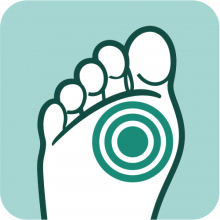Callus
What are calluses?
A callus is a local thickening of the topmost layer of your skin (also known as the epidermis). Calluses naturally occur at spots where the skin experiences pressure and friction. A thin layer of callus is often present under the foot to protect the skin. We call this a physiological callus. In some cases, the epidermis keeps thickening, causing pain. In this case, we speak of excess or pathological callus. It is important to regularly remove this callus with a pedicure or medical pedicure.
Description callus on the foot
A callus is yellow in colour. It generally occurs on the ball of your foot, the heel and/or up, under, on or between the toes. A callus can also grow on the side of your foot sole. Calluses can cause great discomfort. For example, they can make your feet feel fatigued and/or painful. Calluses can lead to corns or chaps. You may also simply find them intrusive and unappealing yellow spots. If so, you can simply have these persistent calluses removed by a pedicurist or medical pedicurist. We advise to hire a professional to do so rather than start working with a callus file yourself. A smooth and healthy skin is very important for your feet. The pedicurist or medical pedicurist from ProVoet can advise you on this. Pathological calluses are created by external excess pressure. For example, due to shoes or socks that do not fit or incorrect positioning of the feet. People with a lot of transpiration may also develop extra calluses. If callus concentrate on a very small area, it may actually be a corn. If a callus becomes very thick and dry, it can lead to chapping. Would you like to know more about corns or chapping? Please see our topics: corn on the foot or chapping of the foot.
Symptoms of calluses on the foot
A callus is commonly hardened and yellow in colour. The skin can feel thicker and rough.
Causes of calluses
If one area of your foot experiences a lot of friction or pressure, then more skin cells are produced in the epidermis than die there. This results in a callus. Causes of increased pressure include obesity, incorrect positioning of the feet and/or toes and poorly fitting shoes and/or socks. Walking on shoes with high heels also creates an unnatural position for your feet, which may lead to calluses on the front of your feet. Some people form more calluses than others. If your skin is dry, your chances of calluses increase. As the sebum production slows, especially elderly people often experience a dry skin – and thus calluses. Highly perspiring feet or a deviating position of the feet also increase chances of calluses.
What can you do about calluses on feet?
A callus is never entirely preventable. Your feet need a small layer of callus to protect the skin. However, you can try to keep your skin flexible. Thoroughly dry your feet after washing them (preferably with warm water). Particularly pay attention to drying between the toes. Applying foot cream to your feet daily ensures your skin is nourished and remains flexible. We advise that you use a care product especially designed for your feet. Never apply foot cream between the toes. This keeps your feet nice and soft, it prevents painful chapping and your feet will look nourished and clean.
Remove calluses?
Do you suffer from excessive calluses? We advise you to visit a ProVoet pedicurist or medical pedicurist. The pedicurist will not only help you remove any persistent calluses, but also help you to treat any corns. In addition, the pedicurist can trace the cause of your calluses and advise you on preventive measures. Do you have at-risk due to diabetes mellitus, a rheumatic condition, cancer, circulatory disease or neurological or dermatological conditions? Then we advise you to visit a medical pedicurist.
